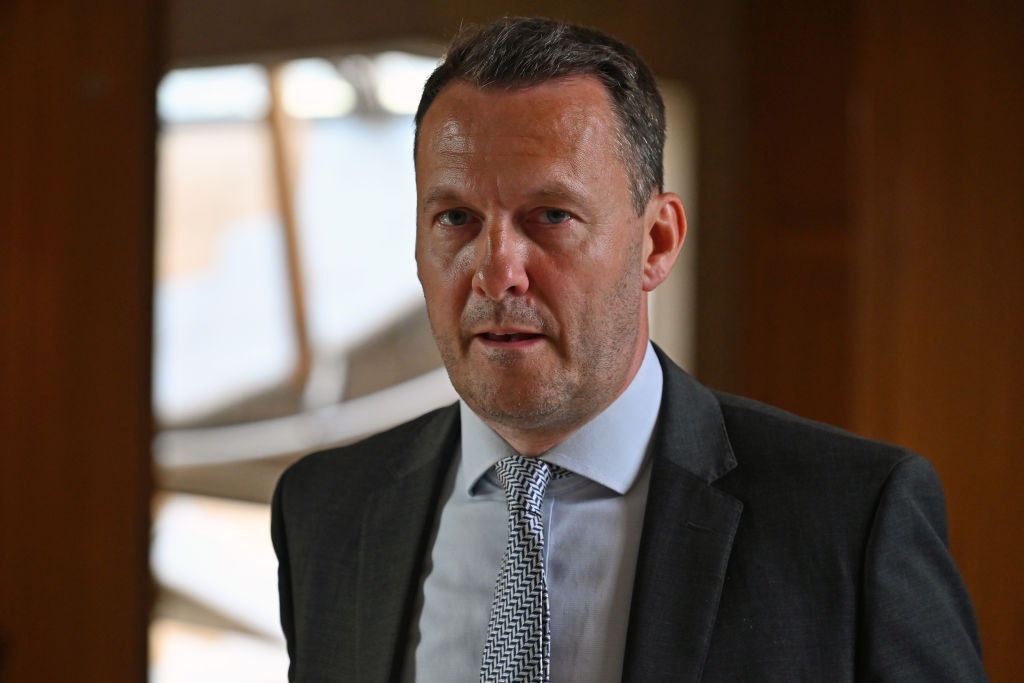Has the government overreacted to the Coronavirus Crisis?
Toby Young questions whether the drastic measures put in place now will harm us more in the future
Like a growing number of people, I’m beginning to suspect the Government has overreacted to the coronavirus crisis. I’m not talking about the cost to our liberty, although that’s worrying, but the economic cost. Even if we accept the statistical modelling of Dr Neil Ferguson’s team at Imperial College, which I’ll come to in a minute, spending £350 billion to prolong the lives of a few hundred thousand mostly elderly people is an irresponsible use of taxpayers’ money. That may sound cold-hearted, but this isn’t a straightforward trade-off between public health and economic health. People are killed by economic downturns just as surely as they are by pandemics and more years of life will be lost than saved if the lockdown is prolonged. The Government should end it as soon as possible and encourage people to return to work, limiting social distancing measures to the elderly and those with underlying health conditions.
People are killed by economic downturns just as surely as they are by pandemics and more years of life will be lost than saved if the lockdown is prolonged
Let’s begin by assuming Imperial College’s numbers are correct. On march 16th, Dr Ferguson’s team predicted there would be 510,000 fatalities if the Government did nothing, 250,000 if it continued with its mitigation strategy and 20,000 if it switched to suppression. In other words, 230,000 lives would be saved if the Government locked everyone down. These are the numbers that persuaded Boris Johnson and the Cabinet to switch tack.
So at its simplest, the Government has valued each life at £1,521,740 (£350 billion divided by 230,000). Now, that’s almost certainly over-egging it. The Imperial College team estimated 250,000 would die if everyone who required medical treatment received it, which they wouldn’t because the NHS lacks the capacity to treat that many people. In addition, there wouldn’t be zero economic cost to mitigation, which involves home quarantining of suspect cases and those living in the same households, and social distancing of the elderly and others most at risk – Rishi Sunak would need to take some measures to offset those costs as well. Finally, the £350 billion the Chancellor has committed to bailing out the economy isn’t a complete write-off. £330 billion of it takes the form of Government-backed loans and some of those will be repaid. So let’s adjust the denominator upwards to, say, 370,000 (the midpoint between 230,000 and 510,000) and the numerator downwards to, say, £185 billion. That yields a cost per life of £500,000.
Is that high? That depends on how many years of life you’re adding to each of the people saved. The National Institute for Clinical Excellence (NICE), which decides which new drugs and medical procedures to fund, places a value of up to £30,000 on each quality-adjusted life year (Qaly). That is, when evaluating how to spend taxpayers money on saving lives, NICE says we should be spending no more than £30,000 to add one year of perfect health to one person.
How many Qalys will the Government be adding to those people whose lives would otherwise be lost to coronavirus if the lockdown hadn’t been imposed? For it to be worth spending £500,000 per life, using NICE’s evaluation criterion, the answer would have to be about 16-and-a-half. And that seems optimistic, given that the average age of those who’ve died from the virus in the UK to date is 79.5 and average UK life expectancy is just short of 81. This suggests the lockdown is extending the lives of 370,000 people by an average of less than one-and-a-half years.
Of course, the average age of coronavirus fatalities would be younger if the critical care capacity of the NHS was overwhelmed – which it would be eight times over if we had stuck with mitigation, according to Dr Ferguson. Remember, 79.5 is the average age of those patients the NHS is unable to save in the current circumstances. The independent researcher Noah Carl has calculated that the average number of life years added to each of the people who would have died if we’d continued with mitigation is 11. But even if we assume those are 11 years of perfect health – not the case, since the majority of people who die of COVID-19 have underlying health conditions – we’re still over-valuing those lives since NICE would price those 11 years at £330,000, not £500,000.
Before we get on to the number of life years that will be lost as a result of the lockdown, it’s worth pointing out that if the Government is prepared to spend £185 billion to extend life it could have done it in dozens of ways that would have yielded more Qalys than the path it has taken. For instance, it could have increased the NHS’s annual budget by £18.5 billion for the next 10 years. That is, sticking with mitigation and spending the £185 billion the Chancellor is spending on offsetting the impact of suppression on the NHS would almost certainly have saved more lives.
Okay, what about the loss of life caused by the inevitable economic recession? During this crisis, politicians have had an annoying habit of contrasting the sacred value of human life with secular, economic values and asserting that it would be morally unacceptable to trade off the former against the latter. Thus, Rishi Sunak repeatedly said he would do “whatever it takes” to save lives, while New York’s Governor Andrew Cuomo said, “I’m not willing to put a price on a human life.” Setting aside the fact that policy makers frequently do put a price on human life – when deciding how to allocate health resources, for instance – these high-sounding pronouncements ignore the fact that economic downturns cost lives. The choice politicians are making is not between saving lives and economic growth, but between sacrificing lives now and sacrificing them in the future. Being politicians, they’ve plumped for short-termism but they shouldn’t pretend that’s an act of great moral courage.
When economies contract, life expectancy declines, due to, among other things, a rise in poverty, violent crime and suicide. During the global financial crisis of 2007– 09, the suicide rate in the United States increased by 4.8% according to the Center for Disease Control and in Europe by 6.5% according to the World Health Organisation. Philip Thomas, professor of risk management at Bristol University, has calculated that if the UK’s GDP falls by more than 6.4% per person as a result of the lockdown, more years of life will be lost than saved, using Dr Ferguson’s estimates. Professor Thomas points out that GDP per head fell by 6% in the UK during the financial crash of 2007 – 09 and many economists are predicting the negative impact of the lockdown will be at least twice as large. “The challenge for the UK Government will be to manage its interventions so that the inevitable impending recession is not significantly worse than the 2007 – 2009 financial crash,” he concludes. If it is, the cure will be worse than the disease.
In light of these considerations, it would be unwise for the Government to extend the lockdown for a further six months, as reported in Monday’s papers. On the contrary, it shouldn’t extend it beyond the scheduled three weeks, i.e. bring it to an end on April 14th, the day after Easter Monday. If it must extend, it should only do so for one week, enabling schools to re-open on April 20th.
The choice politicians are making is not between saving lives and economic growth, but between sacrificing lives now and sacrificing them in the future
Admittedly, that will be politically difficult if it results in the NHS being overwhelmed and the television news starts broadcasting nightly footage of patients dying in hospital corridors. But it may be that Dr Ferguson and his team have over-estimated the demand for ICU beds. The Imperial College model assumes that the Case Fatality Rate (CFR) is 0.9%, but that number may be too high. We know the denominator – the number of COVID-19 deaths – but not the numerator – the number of people who’ve been infected. According to another study carried out by a team at Oxford University, it’s possible that half the UK population have already been infected. If that’s true, not only does it mean the CFR is lower than 0.9% – Dr Jay Bhattacharya of Stanford Med believes it’s closer to 0.1% – it also means the country is well on its way to acquiring herd immunity and the much-ballyhooed “peak” that we’re trying to avoid by locking ourselves down won’t materialise. It’s also worth bearing in mind that Dr Ferguson revised his estimate of the NHS’s surge capacity downwards in the March 16th report, and that may have been unduly cautious given how well the NHS has responded to the crisis in the two weeks since and the number of newly-built hospitals that will shortly come online. For instance, the Nightingale Hospital in the ExCeL Centre, which will have the capacity to treat 4,000 patients, is due to open this week.
Even so, the Government may still be unwilling to take the risk – or, rather, it may be unwilling to risk taking a decision that will mean a rise in visible deaths even though prolonging the lockdown will inevitably mean a greater number of invisible deaths. In which case, as soon as the Department of Health and Social Care takes receipt of the 3.5 million serological tests it has ordered, it should test a large representative sample of the UK population to determine just what percentage has been infected. That will enable the Government to make a more accurate estimate of the number of people likely to require critical care if the suppression measures are relaxed. I strongly suspect it will be well within the NHS’s newly-enlarged surge capacity. One reason for optimism is that in Sweden and Japan, where the Governments have continued to pursue mitigation strategies, the health services have not been overwhelmed.
Some people reading this will think, “I bet he changes his tune if he gets the virus.” In fact, I’ve got the virus. I became symptomatic seven days ago, have been bedridden ever since and am now anxiously waiting to see if the disease spreads to my lungs. I’m 56 with no underlying health conditions, so my odds are good. But if the Government follows my advice, and it turns out that by the time I require urgent care the NHS cannot accommodate me, I won’t regret writing this. Yes, I probably have at least 20 years of healthy living ahead of me, so my life is worth more than £500,000, but I’ll be the exception. In the unlikely event of the NHS being overwhelmed, the majority of people whose lives could have been saved only have one or two years left and those will not be good years. It isn’t worth spending £185 billion to save them, nor is it worth a 15% drop in GDP which will result in a greater loss of life. My death would be acceptable collateral damage.
Enjoying The Critic online? It's even better in print
Try five issues of Britain’s most civilised magazine for £10
Subscribe














